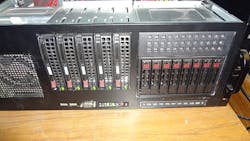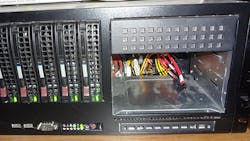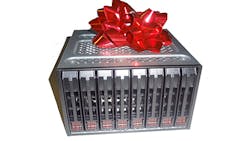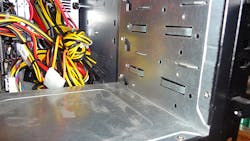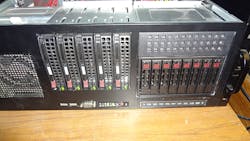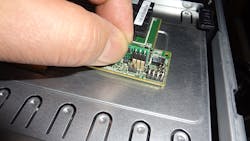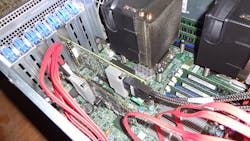The Super Microcomputer (SuperMicro) SuperServer 6046T-TUF I put together a while ago is still going strong but it had a trio of 5.25-in drive bays that were going to waste (Fig. 1). Of course, these days 5.25-in hard drives are history and even 3.5-in hard disk drives (HDD) are being used for high capacity applications. The cutting edge tends to be 2.5-in solid state drive (SSD) and HDDs.
Mounting the rack was an interesting exercise but rather quick because of the SuperMicro case. The case has a triangular stop (Fig. 3) for each drive bay. It is simply a matter of adding a screw to the side of the Mobile Rack, slide it in, and lock it in place.
There is one caveat for the SuperServer 6046T-TUF system. It turns out that the mounting hole alignment requires the rack to be mounted upside down (Fig. 4). That does not make a difference in connecting cables or operation of the hot swap drives.
Removal of the rack is just as simple. There is a release button that allows the rack to be removed. Of course, cabling needs to be removed first.
Filling in the Rack
The first step is add some drives to the rack. For this project I used five Seagate 15K Saviio drives. These high speed, 6 Gbit/s SAS drives are designed for high performance systems. Configuring them into a RAID 5 system provides redundancy.
Of course, these days flash storage is even faster but hard disks are still more cost effective when it comes to capacity. Some environments can afford the cost of flash storage and there are some very large systems that use nothing but flash storage. In this case we have a compromise with three slots for some Micron M500DC (see “Enterprise SSD Targets Big Data Applications”) enterprise 6 Gbit/s SATA solid state drives (SSD). The M500DC is designed for a 5 year life assuming 1 to 3 drive fills per day.
I will have a second article that will address the various configurations I tested. This includes using the flash drives as a conventional RAID system as well as using them in another configuration to cache the RAID 5 hard disk array.
The last piece to the puzzle is the Avago Technologies’ LSI MegaRAID 9361-8i. One feature that will used is the CacheCade support. This allows the controller to use flash drives to cache the contents of the hard disk drives. The CacheCade software is enabled with a small key that has to be plugged into the board (Fig. 5). More about CacheCade in the next article (see "The Joys of SSD Caching").
The MegaRAID 9361-8i board was installed next to another LSI SAS controller that was handling the 3.5-in hard drives (Fig. 6). LSI’s MegaRAID Storage Manager can handle both although caching works within one controller.
The hardware installation actually goes rather quickly. The most time was taken up with installation of the HDDs and SDDs in the hot swap drive trays. Plugging in the MegaRAID 9361-8i and cables takes just a few minutes.
The mobile rack works with any controller. Another alternative for this configuration would be to use a SAS expander and connect it to the existing SAS controller. A SAS expander is typically found in disk racks with dozens of drive bays. A single SAS connection is needed between the SAS controller and these systems. SAS expanders normally have a lot of connections so one could handle multiple mobile racks.
I am off to checking out the MegaRAID Storage Manager (MSM) software.
About the Author
William G. Wong
Senior Content Director - Electronic Design and Microwaves & RF
I am Editor of Electronic Design focusing on embedded, software, and systems. As Senior Content Director, I also manage Microwaves & RF and I work with a great team of editors to provide engineers, programmers, developers and technical managers with interesting and useful articles and videos on a regular basis. Check out our free newsletters to see the latest content.
You can send press releases for new products for possible coverage on the website. I am also interested in receiving contributed articles for publishing on our website. Use our template and send to me along with a signed release form.
Check out my blog, AltEmbedded on Electronic Design, as well as his latest articles on this site that are listed below.
You can visit my social media via these links:
- AltEmbedded on Electronic Design
- Bill Wong on Facebook
- @AltEmbedded on Twitter
- Bill Wong on LinkedIn
I earned a Bachelor of Electrical Engineering at the Georgia Institute of Technology and a Masters in Computer Science from Rutgers University. I still do a bit of programming using everything from C and C++ to Rust and Ada/SPARK. I do a bit of PHP programming for Drupal websites. I have posted a few Drupal modules.
I still get a hand on software and electronic hardware. Some of this can be found on our Kit Close-Up video series. You can also see me on many of our TechXchange Talk videos. I am interested in a range of projects from robotics to artificial intelligence.
